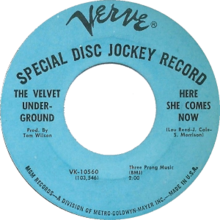Here She Comes Now
| "Here She Comes Now" | ||||
|---|---|---|---|---|
 | ||||
| Single by The Velvet Underground | ||||
| from the album White Light/White Heat | ||||
| A-side | "White Light/White Heat" | |||
| Released | January 1968 | |||
| Recorded | September 1967 | |||
| Studio | Scepter, New York City | |||
| Genre | Psychedelic folk[1] | |||
| Length | 2:04 | |||
| Label | Verve | |||
| Songwriter(s) | ||||
Tom Wilson | ||||
| The Velvet Underground singles chronology | ||||
| ||||
"Here She Comes Now" is a song released by the American rock band the Velvet Underground in January 1968, from their second studio album White Light/White Heat.[2] As the shortest song on the album, the performance and mix of the song are both considered simple and traditional, making it somewhat distinct from the other five songs on the album, all of which contain some degree of experimental or avant-garde elements in terms of sound.[3][4]
Background
"Here She Comes Now" was recorded during the recording sessions for White Light/White Heat in September 1967 at Scepter Studios in Manhattan.[5] Lou Reed originally intended the song to be sung by Nico, who had sung it on a few occasions during the Exploding Plastic Inevitable events, however her collaboration with the group had ended before recording for White Light/White Heat had begun. Subsequently, Reed had decided to take over vocals for the song.[6][7] The song was first demoed in two takes during the winter of 1967 by Reed, Sterling Morrison and John Cale at their Ludlow Street apartment. In 1995, the demo was released on the box set Peel Slowly and See.[8][9]
Lyrical interpretations
The
Critical reception
Eddie Gibson of Music Review Database praised the song as "one of the more beautiful tracks from White Light/White Heat". He described the instrumentation as "delicate and in an acoustic manor" [sic] and said "it's something spectacular because the guitar is very delirious and the sparse drumming only adds to the beautiful atmosphere". He also commented that the delayed reverb gave the song a "sweet, melancholy edge over the rest of the album".[3] Uncut described it as "a soothing mantra that served as a brief moment of balm amongst the blistering noise, a guttering light in the churning darkness".[4] Similarly, Mark Deming of AllMusic considered it "the album's sole 'pretty' song" and "mildly disquieting".[12] Authors Scott Schinder and Andy Schwartz deemed the song "the album's lone melodic ballad" that "carried an uneasy undercurrent".[13] Author Doyle Greene considered the track "a brief and relatively sedate song closest to the psychedelic folk leanings of the first album".[1]
Recordings and personnel
Although known to have been played live, no other recorded versions than the demo and the White Light/White Heat studio version are known to exist.
1967 demo personnel
- lead vocals, rhythm guitar
- Sterling Morrison – lead guitar
- John Cale – viola[14]
1967 studio personnel
Cover versions
Nirvana
A version of the song was recorded by American rock band
Other versions
Cabaret Voltaire recorded a cover version on their debut EP Extended Play in 1978.[16]
The song was also covered by dream pop band Galaxie 500 as the B-side for their 1990 single "Fourth of July", with the cover later appearing as a bonus track on reissues of their 1990 album This Is Our Music.[17]
References
- ^ ISBN 978-1-4766-2403-7.
- ISBN 978-1-4735-0895-8.
- ^ a b Gibson, Eddie (June 3, 2011). "The Velvet Underground - White Light/White Heat". Music Review Database. Retrieved June 24, 2016.
- ^ a b "The Velvet Underground – White Light/White Heat Super Deluxe Edition". Uncut. January 23, 2014. Retrieved June 24, 2016.
- ISBN 978-0-500-97668-5.
- Wolfgang's Vault. Retrieved June 24, 2016.
- ISBN 978-88-6231-440-4.
- ISBN 978-0-8108-4582-4.
- ISBN 978-0-7867-3689-8.
- ISBN 978-0-85712-003-8.
- ISBN 978-0-615-93377-1.
- AllMusic. Retrieved June 24, 2016.
- ISBN 978-0-313-33847-2.
- ISBN 978-1-906002-22-0.
- ISBN 978-1-84353-588-1.
- ISBN 978-1-900486-17-0.
- AllMusic. Retrieved June 24, 2016.
